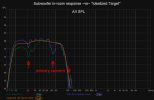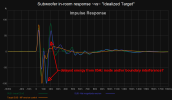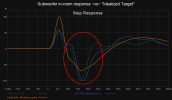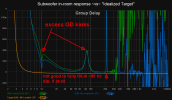ernestcarl
Major Contributor
So when I look at the phase traces in the 4 measurements in your set, I'm bewildered about their phase traces. They aren't anything I know how to work with.
I created a synthetic minimum phase version IR from the sub's target curve (orange trace) to serve as a very simplified control comparison.
In reality, I do not use the "flat" sub equalization version (blue trace) shown below since I equalize for multiple seat positions in the room at large and not just a single MLP spot. It's just there to illustrate what the equalized in-room magnitude response might look like if the very LF adhered to the idealized target more rather than less.
"Align IR start" function was used to auto-adjust the time offsets between the three separate IRs so as to appear closer with each other.
Turns out, things aren't nearly as bad as it seems if you try to see through past the room-induced kinks in the response:







1/6 smoothing default and Log (dB SPL) was used in the wavelet spectrogram.
